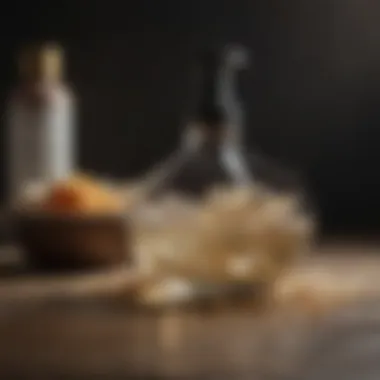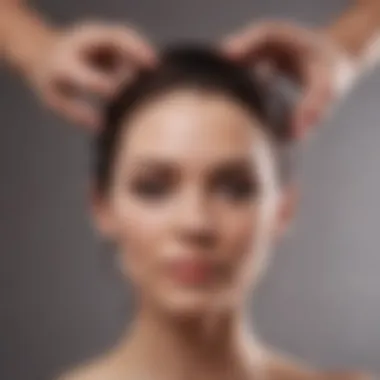How to Repair My Hair: A Comprehensive Guide


Intro
Caring for hair is an urgent need for many individuals, especially in an era where styles change rapidly and external factors can be harsh. With a detailed understanding, anyone can enhance their hair's health. This article provides a roadmap to repairing and rejuvenating hair through targeted practices, products, and mindful techniques. The journey to healthier hair involves recognizing the needs of your specific hair type and addressing common problems effectively.
Key Trends
Overview of Current Hair Trends
In 2023, hair trends reflect a blend of natural textures and bold colors. Many individuals are leaning towards effortless looks that showcase their natural beauty. Hair health is the foundation of these trends. For example, the rise of low-maintenance hairstyles corresponds with a growing focus on nourishment and care. People are prioritizing treatments that repair damage rather than just styling.
Popular Beauty Trends
Moreover, trends point towards embracing sustainability. Clean beauty products are in high demand. Consumers seek solutions that are not only effective but also environmentally friendly. Brands like Briogeo and Olaplex emphasize natural ingredients that repair hair and contribute to overall hair health.
Identifying Common Hair Issues
Understanding your hair is crucial. Many people face dryness, breakage, and split ends. These issues can arise from multiple factors, including:
- Heat damage: Frequent styling with hot tools can lead to weakened strands.
- Chemical treatments: Color treatments and relaxers may strip the hair of its natural oils.
- Environmental exposure: Pollution and sunlight can cause significant harm over time.
Recognizing these issues is the first step toward effective repair.
Practical Solutions for Repair
Nourishing the Hair from Within
To repair hair effectively, one must consider both internal and external factors. A balanced diet enhances hair health. Nutrients essential for hair growth include:
- Proteins: Fish, eggs, and nuts help build keratin, a vital hair structure.
- Vitamins: Especially vitamins A, C, and E promote healthy hair growth.
- Omega fatty acids: Found in avocados and flaxseeds, these keep hair hydrated.
"You are what you eat" - the statement rings true for hair as well. Intaking good nutrients reflects on your strands.
External Treatments
In addition to nutrition, topical treatments play a significant role in repair:
- Deep conditioning masks: Use weekly to restore moisture.
- Leave-in conditioners: Help manage frizz and protect from heat.
- Hair oils: Argan oil or coconut oil nourishes and protects against breakage.
Choosing the right products for your hair type will enhance these effects significantly.
Sustainable Practices
Understanding Sustainable Beauty
Sustainability is becoming more important in hair care. Brands now focus on eco-friendly packaging and natural ingredients. Sustainable practices can greatly benefit both your hair and the planet. For example, environmentally conscious products avoid harsh chemicals that can damage hair over time.
Tips for Sustainable Hair Care
To promote sustainable hair care practices:
- Choose cruelty-free brands: They prioritize product testing methods.
- Consider refills or recyclable packaging: Reduces waste.
- Educate yourself on ingredients: Prioritize products free of sulfates and parabens.
With informed choices, individuals can contribute to a healthier planet while restoring their hair.
Ending
Repairing hair is a nuanced process. By understanding hair health, choosing the right products, and adopting sustainable practices, individuals can achieve remarkable improvements. This comprehensive guide emphasizes the importance of being proactive in both external care and internal nourishment. In a world where hair is often seen as a reflection of identity and style, prioritizing its health is essential.
Understanding Hair Structure and Health
Understanding the structure and health of hair is crucial for effective repair strategies. Hair is a complex structure composed of proteins that require care specifically tailored to their needs. Recognizing the composition and common issues of hair can facilitate an informed approach to hair health. It helps in choosing the right products and routines that complement the natural properties of different hair types.
Anatomy of Hair
Hair consists of three main components: the cuticle, cortex, and medulla. The cuticle is the outermost layer, forming a protective barrier against environmental damage. It consists of overlapping scales that can become damaged through harsh treatments or even daily wear. The cortex lies beneath the cuticle and provides hair its strength and elasticity. It also contains pigments that contribute to hair color. The medulla, often absent in finer hair, is the central core. Understanding these layers aids in identifying how each contributes to overall hair health and can inform repair methods.
Common Hair Concerns
Brittleness


Brittleness refers to hair's tendency to break easily. This often arises from a lack of moisture or excessive styling. A key characteristic of brittle hair is its tendency to feel dry and rough. This makes it an important topic in our guide since repairing brittle hair often involves restoring moisture balance and utilizing gentle hair care practices. While treatments exist to hydrate and strengthen hair, they must be chosen carefully to avoid further damage.
Split Ends
Split ends occur when the protective cuticle wears away, causing the hair shaft to fray. This common issue contributes significantly to the overall health of hair. Split ends can make hair appear unkempt and less vibrant. Addressing split ends is beneficial in a comprehensive hair care routine, emphasizing regular trims and the use of protective products. However, once hair splits, the damage is permanent, necessitating proactive measures to prevent occurrence.
Fading Color
Fading color can affect both natural and dyed hair. As hair is exposed to sunlight and environmental pollutants, its color might diminish or change. This characteristic of fading color is relevant because it affects appearance and confidence. Implementing strategies to maintain vibrancy is critical, especially for color-treated hair. Specific products can be used to protect color and prevent fading, making it a vital topic in hair care discussions.
Excessive Frizz
Excessive frizz creates a wild and untamed look, often resulting from dry, damaged, or porous hair. It can happen due to humidity, lack of moisture, and chemical treatments. The unique feature of frizz is that it indicates hair that lacks smoothness and shine. It’s critical to address it for a polished appearance. Utilizing anti-frizz products and proper hair care routines greatly benefits those experiencing this issue, making it an essential focus in our guide.
"Understanding different hair issues allows for better personal care decisions."
By addressing these common concerns, we can better equip ourselves to restore hair to a healthy state.
Identifying Your Hair Type
Understanding your hair type is a foundational step in the journey to effective hair repair. Each hair type has unique characteristics that influence how it responds to various products and treatments. By identifying your hair type, you can select the right products that cater specifically to your needs. This not only maximizes the health of your hair but also optimizes your efforts in maintaining its condition.
Knowing your hair type helps in addressing specific concerns. For example, individuals with curly hair might need heavier moisturizers compared to straight hair types. Also, identifying hair types allows for a deeper understanding of natural oils, moisture retention, and overall hair behavior under different environmental conditions. Therefore, this section aims to dissect the four primary hair types: straight, wavy, curly, and coily.
Straight Hair
Straight hair typically has a sleek appearance, characterized by its glossy finish and smooth texture. This type of hair is often less prone to frizz because the natural oils from the scalp travel easily down the hair shaft. Thus, it usually appears shinier than other types. However, straight hair can lack volume and may become oily if not washed frequently.
To care for straight hair, choose lightweight shampoos and conditioners that cleanse effectively without weighing the hair down. Incorporating volumizing products can provide lift and body. For those who color their straight hair, consider color-protecting products to maintain vibrancy and shine.
Wavy Hair
Wavy hair features a natural curvature that combines both straight and curly traits. This hair type can range from loose waves to more defined S-shaped curls. Wavy hair can be voluminous and bouncy, yet it is also prone to frizz, especially in humid conditions.
Care for wavy hair by using hydrating shampoos and conditioners. Look for products that enhance wave definitions, such as curl creams or light mousse. For styling, avoid heavy products that can weigh down the waves. Sensitive to moisture balance, this hair type responds well to regular hydration to keep waves defined and frizz at bay.
Curly Hair
Curly hair is characterized by its spiral strands, which can vary in tightness and thickness. This type is often dry as the curls can inhibit the natural oils from reaching the ends. Curly hair tends to be more fragile, requiring extra care and attention.
For curly hair, deep conditioning treatments are essential. Invest in rich, moisturizing products that contain ingredients like shea butter or coconut oil. Ensure you use a gentle shampoo to avoid stripping natural oils. When styling, employ techniques like scrunching and diffusing to enhance curls without causing damage.
Coily Hair
Coily hair, often referred to as afro-textured hair, has a tight, zigzag curl pattern. This hair type is the most fragile and can be prone to breakage if not handled with care. It often requires significant moisture to maintain its health and definition.
Care for coily hair involves using thick, moisturizing products that provide hydration. Products with a higher oil content work well to seal in moisture. It’s advisable to do regular deep conditioning treatments, along with protective styles to minimize breakage. Gentle detangling is also crucial, often best performed when the hair is damp and coated in a leave-in conditioner.
By understanding these hair types and their individual needs, individuals can better equip themselves with the tools necessary for optimal hair health. This awareness serves as a crucial element when the time comes to select appropriate hair care methods and products.
Right Products for Your Hair
Selecting the right products is essential for effective hair repair. The products you use can enhance your hair's health and appearance, directly impacting your ability to manage common issues. Choosing formulations tailored to your specific hair type and concerns ensures that you provide your hair with the care it needs.
It's critical to consider factors such as ingredients, product performance, and potential side effects. Comprehending how each product works allows for better decision-making when it comes to hair care.
Shampoos and Conditioners
Hydrating Formulas
Hydrating formulas play a vital role in maintaining moisture levels within the hair shaft. These products are designed to combat dryness, a common problem for many. They often contain glycerin, aloe vera, and hyaluronic acid, which are known for their ability to attract and retain moisture.
One key characteristic of hydrating formulas is their capacity to improve hair texture. Users often notice smoother, more manageable hair after consistent use. However, it’s important to check the ingredient list, as some hydrating shampoos might contain sulfates. Sulfates can be harsh, potentially leading to more dryness if used too frequently.
Nourishing Ingredients
Nourishing ingredients in shampoos and conditioners contribute significantly to hair health. Elements like keratin, vitamins, and natural oils are essential for repairing and maintaining the integrity of hair strands. The presence of these ingredients aids in rebuilding damaged hair structures and adding shine.
The key characteristic of nourishing ingredients is their ability to penetrate deeply into the hair shaft. This leads to improved strength and elasticity over time, making the hair less prone to breakage. Despite the benefits, some products with heavy oils may weigh hair down, which is crucial to consider, especially for finer hair types.


Deep Conditioning Treatments
Hair Masks
Hair masks are intensive treatments designed for deeper repair. Unlike regular conditioners, masks typically contain higher concentrations of beneficial ingredients. They are often left on the hair for longer periods, allowing for greater penetration and effectiveness.
The primary benefit of hair masks is their ability to restore moisture and nutrients, especially after chemical treatments or heat exposure. Many masks include ingredients like sheabutter and argan oil, making them popular choices among users seeking intensive care. However, overuse can lead to product buildup, which may weigh hair down and make it look greasy.
Oils and Serums
Oils and serums serve as effective tools for enhancing hair health. They can provide shine, moisture, and protection against environmental stressors. Common oils like coconut and jojoba are frequently used for their lightweight texture and optimal absorption.
The unique feature of oils and serums is their multitasking capability. They can smooth frizz, enhance shine, and even protect against heat damage. Although very effective, it is wise to avoid applying too much product, as this can lead to greasiness rather than nourishment.
Heat Protection Products
Heat protection products are essential in any hair care routine, especially for those using styling tools. These products create a barrier between the hair and damaging heat sources, preventing or reducing thermal damage.
Key to these formulations is the presence of silicones and other heat-absorbing ingredients. They work by coating the hair, allowing for better insulation during styling. Not using heat protection can lead to split ends and dryness, which complicates hair repair efforts.
In summary, choosing the right products is integral to a successful hair repair journey. Understanding the specific roles of various products and their ingredients will allow for informed decisions aimed at achieving healthy hair.
Daily Care Routines
Daily care routines are essential in maintaining healthy hair. A consistent approach can help prevent issues like brittleness, excessive frizz, and even split ends. Recognizing how to care for your hair daily is a foundational aspect of hair repair. It not only involves selecting the right products but also implementing proper techniques during washing, drying, and styling.
By addressing these routines, individuals can create an environment that promotes hair health and recovery.
Washing Frequency
Washing your hair too often can strip it of natural oils, leading to dryness. For most hair types, it is recommended to wash hair every two to three days. People with curly or coily hair might extend this period further since their hair tends to be drier. On the contrary, those with straight and oily hair may need to wash it daily to maintain a clean feel. It’s crucial to identify and listen to your hair's needs. Consider using a gentle, sulfate-free shampoo that cleans without harsh chemicals. This adds to maintaining the natural moisture in your hair.
Proper Drying Techniques
After washing, the way you dry your hair is equally important. Rubbing hair vigorously with a towel can cause damage and lead to frizz. Instead, try gently squeezing the excess water out. If possible, consider air-drying your hair whenever you can. If you have to use a hair dryer, keep it on a low heat setting and maintain some distance from your hair. This minimizes heat damage and keeps your hair healthier in the long run.
Brushing and Styling
Brushing and styling practices also play a role in daily hair care. Here, we will discuss two primary subtopics: using the right tools and gentle handling.
Using the Right Tools
Using the right tools is fundamental for maintaining hair integrity. A wide-toothed comb can be especially helpful for detangling wet hair. It minimizes breakage, unlike fine brushes that pull and tug aggressively. Quality brushes made with natural bristles can distribute oils from the scalp down the hair shaft, enhancing shine. They are a popular choice among hair care enthusiasts due to their gentle action. Opting for appropriate tools tailored for your specific hair type ensures that you protect your hair while achieving your desired style.
Gentle Handling
Gentle handling is crucial for preventing damage. Hair is most vulnerable when wet, making it more susceptible to breakage. Therefore, avoid aggressive styling techniques. Be gentle while brushing and use soft, smooth motion. When it comes to tying your hair up, use fabric-covered bands instead of rubber ones. These factors are beneficial in protecting hair from unnecessary strain and injuries. Cultivating a gentle approach in your daily routine enriches overall hair health and boosts repair efforts over time.
Remember, consistency is key. Adopting a daily care routine that incorporates these principles can lead to long-term benefits for your hair.
Nutrition and Hair Health
Nutrition plays a pivotal role in the health of our hair. The relationship between what we eat and the condition of our hair is significant. Nutrients do not only support overall well-being but also directly influence hair strength, growth, and shine. A poor diet can lead to issues such as hair thinning, brittleness, and excessive hair loss. Thus, understanding which vitamins and minerals are essential is critical.
Essential Vitamins and Minerals
Vitamins and minerals are crucial for maintaining vibrant hair. For instance, Biotin, a B-vitamin, is known to improve hair health by supporting keratin production. This is important because keratin is the primary protein in hair. Vitamin A promotes the production of sebum, a natural oil that moisturizes the scalp. Lack of it can lead to a dry scalp and dull hair. Vitamin E, on the other hand, enhances blood circulation in the scalp, promoting better nutrient delivery to hair follicles.
Additionally, minerals such as iron and zinc contribute to hair growth and repair. Iron helps red blood cells carry oxygen, essential for hair cell metabolism. Meanwhile, zinc assists in maintaining the structural integrity of hair follicles.
Dietary Considerations
Hydration
Hydration is critical in maintaining healthy hair. Our body is composed of a significant percentage of water, and so is our hair. Ensuring that you drink enough fluids daily influences the moisture levels of the hair. Dehydration can cause hair to become dry and brittle, leading to breakage. Consuming adequate amounts of water not only benefits hair health but also improves skin conditions and overall bodily functions. It’s a simple yet powerful way to support vibrant hair.
Balanced Diet
A balanced diet incorporates a variety of foods and nutrients essential for hair health. It ensures that the body receives the right ratio of proteins, carbs, and fats, which are necessary for hair growth and repair. Consuming foods like fish, nuts, seeds, leafy greens, and whole grains can provide the necessary nutrients. A balanced diet supports not just hair health but overall body functionality, reducing issues related to stress and fatigue that could further impact hair quality. Consistency in maintaining such a diet is key to seeing long-term benefits in hair repair.
Lifestyle Factors Affecting Hair Repair


Lifestyle choices play a crucial role in determining the health and appearance of hair. Ignoring these factors can result in ongoing issues that hinder repair efforts. Understanding how daily habits impact hair health allows individuals to adopt more effective strategies, thereby promoting stronger, healthier hair.
Stress Management
Stress is a significant factor affecting hair repair. When the body experiences stress, it triggers various physical reactions that can be detrimental to hair health. Chronic stress can lead to hair loss, excessive shedding, or even conditions like telogen effluvium. Managing stress through various methods such as mindfulness, exercise, or relaxation techniques can help maintain hair vitality.
"Incorporating stress-relief practices into daily routines is essential for better hair health."
Sleep Patterns
Adequate sleep is vital for overall body health, including hair repair. During deep sleep, the body engages in regenerative processes that rejuvenate cells, including those in hair follicles. Poor sleep patterns can disrupt hair growth cycles, leading to thinning hair or slow growth. Establishing a proper sleep routine can significantly enhance hair repair efforts, making it important to prioritize sleep hygiene practices.
Environmental Factors
Sun Exposure
Sun exposure can have a dual impact on hair health. On one hand, moderate sun exposure aids in the production of vitamin D, which is beneficial for hair health. On the other hand, excessive exposure can damage hair by leading to dryness and brittleness. It is essential to balance sun exposure and protect hair using hats or UV-protectant sprays.
- Key characteristic: Protects against some deficiency by encouraging vitamin D synthesis.
- Advantages: Can boost overall hair health when exposure is moderate.
- Disadvantages: Prolonged exposure can lead to dryness and damage.
Pollution
Pollution is another environmental factor that negatively impacts hair health. The presence of harmful particles in the air can settle on the scalp and hair, leading to premature aging and damage. Regular cleansing and using products designed to remove pollutants can mitigate these effects.
- Key characteristic: Can penetrate hair cuticles, causing damage over time.
- Advantages: Awareness of pollution impact can encourage better hair maintenance routines.
- Disadvantages: Leads to accumulated damage if hair is not properly cared for.
In summary, addressing lifestyle factors is a critical component of hair repair strategies. By managing stress, ensuring adequate sleep, and protecting hair from environmental hazards, individuals can significantly improve the condition and appearance of their hair.
Professional Treatments
Professional treatments play a crucial role in the overall health and repair of your hair. While at-home care can address many concerns, certain issues may require the expertise found in salons or specialized clinics. Engaging in professional hair treatments can provide you with tailored solutions to specific problems that over-the-counter products might not effectively manage.
These treatments not only target individual needs but also often incorporate high-quality, professional-grade products that are not available for retail purchase. Additionally, they are administered by trained professionals who understand the nuances of hair types, textures, and conditions.
Salon Treatments
Salon treatments offer a variety of services specifically designed to nourish and rejuvenate hair. These are some common salon treatments:
- Deep Conditioning: A deeper level of hydration that penetrates the hair shaft. This helps in restoring moisture and vitality.
- Keratin Treatments: These treatments aim to smoothen frizz and straighten the hair while improving shine. It fills in the damaged areas with keratin, leading to healthier-looking strands.
- Hair Color Revitalization: If color damage is a concern, salons often provide gloss treatments or color correction services that help restore vibrancy.
- Scalp Treatments: Various options are available, including exfoliation and hydration treatments that address scalp health directly, important for healthy hair growth.
The benefits of salon treatments are manifold. Not only do they improve the immediate appearance of hair, but they also contribute to its long-term health. Each procedure is specifically designed to target issues such as dryness, damage, or lack of shine, leading to a more manageable and vibrant mane.
Hair Health Consultations
Hair health consultations are an essential component of professional treatment avenues. During these consultations, a specialist evaluates individual hair and scalp condition, taking into account various factors like damage levels, hair type, and lifestyle.
- Customized Recommendations: Based on the evaluation, professionals can recommend specific treatments or product lines tailored to meet your unique needs.
- Education: Professionals often provide valuable insight into effective hair care practices and the role of nutrition in overall hair health. This includes dietary suggestions that can enhance hair condition from the inside.
- Follow-up Care: These consultations often lead to structured care regimens that help maintain results achieved through professional treatments.
"Investing time and resources in professional treatments can yield significant returns in hair vitality and overall aesthetic."
In summary, professional treatments should not be overlooked when considering hair health. The combination of expert analysis and targeted treatments can be transformative, bringing about changes that are both immediately visible and beneficial in the long run.
Sustainable Practices for Healthy Hair
Sustainable practices are increasingly becoming vital in all aspects of life, including hair care. As consumers grow more aware of the environmental impact of their choices, the call for eco-friendly hair care becomes louder. Implementing sustainable practices can lead to healthier hair as well as benefit the planet. This section delves into how sustainable methods can improve hair health while fostering a responsible attitude towards the environment.
Choosing Eco-Friendly Products
Opting for eco-friendly hair care products offers numerous advantages. These products are formulated with natural ingredients, minimizing exposure to harmful chemicals. Common harmful substances like sulfates, parabens, and synthetic fragrances not only affect hair health but can also pose risks to human health and the environment. By using organic products, individuals support sustainable farming practices, which helps reduce pollution and promotes biodiversity.
When selecting eco-friendly hair care products, consider the following elements:
- Ingredients: Look for natural, plant-based ingredients that nourish hair without negative side effects.
- Certifications: Seek products with certifications like USDA Organic or cruelty-free labels to ensure ethical sourcing and production.
- Packaging: Choose brands that use recyclable or biodegradable materials. This reduces landfill waste and promotes a circular economy.
By making conscious choices, individuals can significantly reduce their carbon footprint while maintaining or improving their hair health.
Reducing Waste in Hair Care
Reducing waste in hair care involves strategies that minimize environmental impact. Hair care can be resource-intensive, from single-use plastic bottles to disposable products. Here are some practices to help decrease waste:
- Refill Systems: Use brands that offer refill options to avoid purchasing new containers frequently. This practice minimizes plastic waste.
- DIY Products: Consider creating homemade hair care products using simple, natural ingredients like coconut oil and aloe vera. This method reduces packaging waste and allows for customization.
- Mindful Purchases: Avoid impulse buying of products and stick to what your hair truly needs. This not only saves money but also prevents unnecessary waste.
Implementing these practices contributes to a more sustainable hair care routine. Practicing sustainability can enhance hair health and aligns with a broader commitment to environmental responsibility.
"Sustainable choices in hair care represent a step towards a healthier planet and healthier hair."



